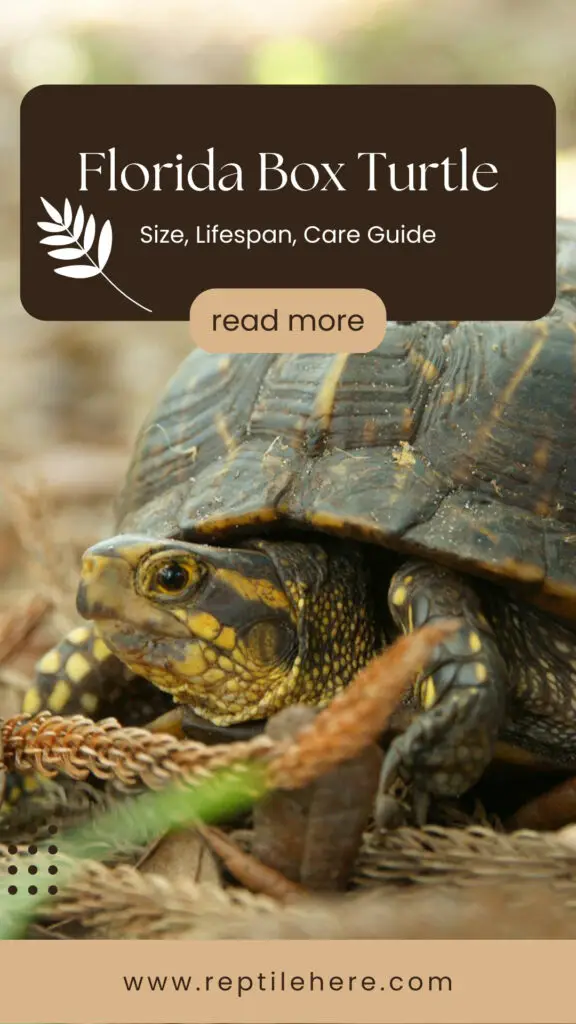Florida Box Turtle: Size, Lifespan, Care Guide
The Florida box turtle is one of the best pet turtles you can keep. It’s fairly small, tolerant to handling, and rarely bites. But before you bring this species home, you need to understand its special needs and commit yourself to take good care of it.
Florida box turtle care includes providing it with an appropriate size enclosure with proper lighting, correct temperature, and humidity levels. Feed it with a healthy, balanced diet, and take it to your vet for a checkup at least once every year. With proper care, your box turtle can last for 30 to 40 years.
In this guide, we’ll delve into more details about everything you need to know about taking good care of your Florida box turtle pet, how to set up its habitat correctly, what to feed it, lifespan, and more.
Florida Box Turtle Overview:
Contents
- Common name: Florida box turtle
- Scientific name: Terrapene carolina bauri
- Size: 5 to 6.8 inches (males), 4 to 5 inches (females)
- Diet: Omnivore
- Distribution: Florida and the extreme southeastern part of Georgia
- Difficulty of care: Intermediate
- Lifespan: 30 to 40 years
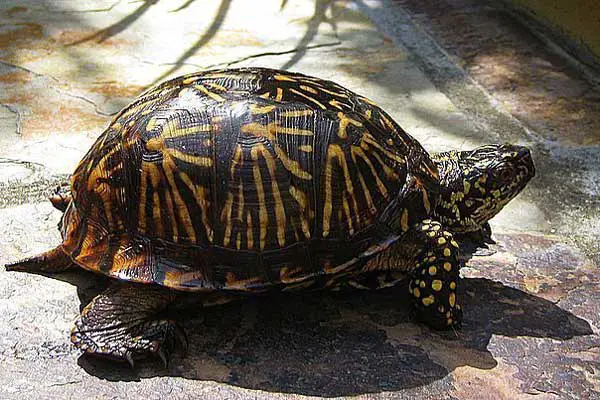
Can you keep a Florida box turtle as a pet?
You can keep a Florida box turtle as a pet. This species is fairly small and not aggressive (it doesn’t bite humans!). It’s also pretty interesting to watch as a pet and it likes being handled. Just make sure you don’t overdo it.
But keep in mind that this turtle isn’t low maintenance and requires serious commitment. It’s not an ideal turtle for a beginner turtle owner with no experience taking care of turtles.
If you want to keep this turtle as a pet, you must be committed to taking good care of it. Or you can find someone to do it for you if you won’t be available or something happens to you.
You also need to check what your local laws say on the ownership of Florida box turtles or box turtles in general.

For instance, if you live in Florida, then the Florid Fish and Wildlife Conservation Commission state that you’re allowed to own no more than two box turtles. It’s also illegal to sell these turtles, their parts, or eggs taken from the wild.
How big does a Florida box turtle get?
This is a small to medium-sized turtle species with an average size of around 4.33 inches.
As with most turtle species, female turtles usually grow bigger than male turtles. A typical male has an average size of 4 to 5 inches while an average female size is 5 to 6 inches.
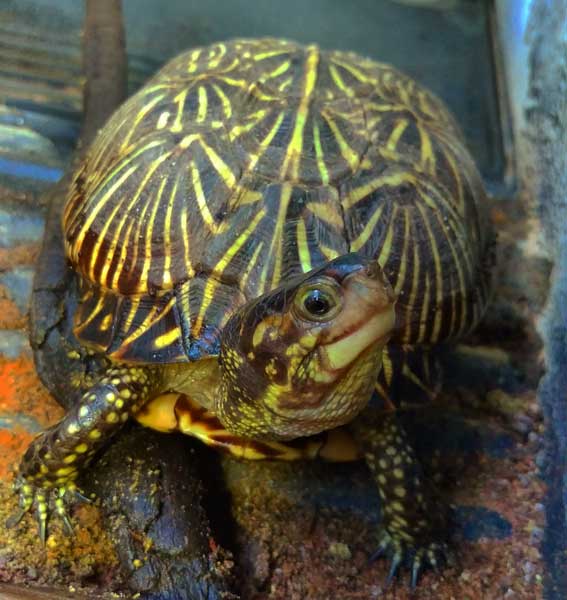
Keep in mind that the Florida box turtle size can be affected by the habitat as well as the diet. Generally, wild box turtles will grow bigger than captive ones, whose sizes can be easily limited by the enclosure.
Also, if you feed your turtle a protein-rich diet, it’s likely to grow larger than a turtle that has a balanced diet.
Florida box turtle enclosure
As mentioned earlier, you can house your Florida box turtle in an indoor enclosure or an outdoor pen.
For each type of enclosure, there are certain measures you need to keep in place to ensure your pet stays happy and healthy.
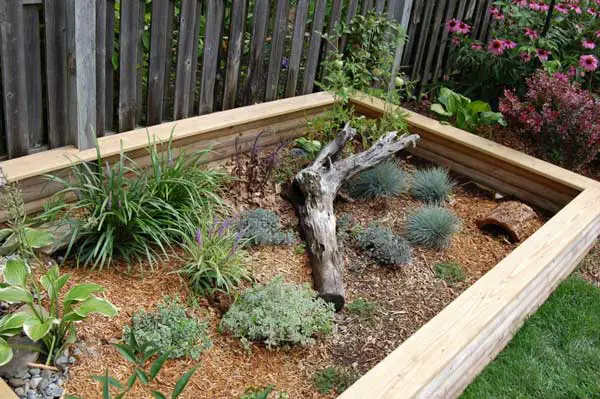
Let’s take a closer look at the basics of each type of setup:
Outdoor housing
An outdoor pen is the best option for housing this turtle. A pen as big as 4’ x 8’ will accommodate 3-4 of your box turtles.
You can come up with your own pen or buy an animal cage, such as a dog crate from the pet stores. Set the enclosure in the open so your pet enjoys unlimited access to sunlight.
Be sure to cover your enclosure at the top to keep off potential predators.
An underground barrier is also necessary since box turtles are good diggers and can dig under the enclosure walls and escape.
It should also be equipped with plenty of hiding spots using non-toxic turtle plants and items such as clay pots turned upside down and buried partially.
A moist substrate is also necessary for this type of enclosure to help your turtles easily burrow themselves and bring out their natural behavior.
Note that these turtles like soaking in the water, so you should also provide them with a large water bowl where they can soak in.
If you have more than one turtle, make sure the swimming area is large enough to accommodate all of them comfortably.
Remember to change the water frequently so it stays clean and prevents health issues from getting to your turtle.
Indoor housing
If you prefer an indoor habitat for your box turtle pet, then you’ll need to get the appropriate size enclosure to accommodate the turtle comfortably.
The temperature for this indoor habitat should be around 70 to 90 degrees Fahrenheit to enable your turtle to regulate its body temperature.
A heat lamp is also necessary for keeping the basking area warm. A UV lamp is also needed to provide your turtle with UVB rays necessary for vitamin D3 production and proper absorption of calcium from their diet.
Other things to consider for the indoor habitat include plenty of hiding spots, appropriate substrate, and water bowls where your turtle can soak in from time to time.
Florida box turtle diet
The Florida box turtle is omnivorous and will eat vegetation as well as animal proteins.
Feed your pet turtle plant matter including dark leafy greens such as spinach, parsley, mustard greens, collard greens, dandelion greens, beet topics, flowers, and kale.
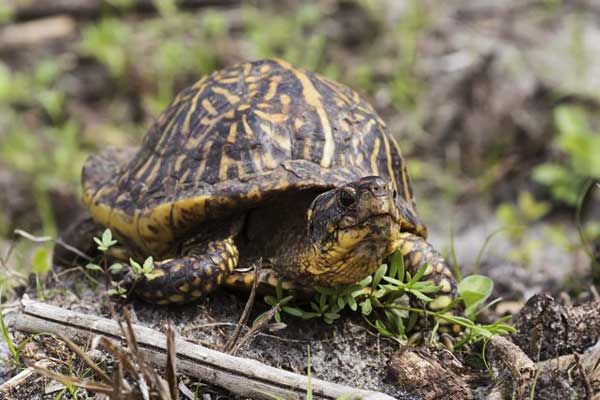
You can also feed them small quantities of romaine lettuce, green beans, and fruits such as blackberries, sliced apples, raspberries, and mulberries.
As for the animal proteins, feed your turtle crickets, mealworms, earthworms, or slugs. Commercial pellets are also good for your box turtle.
Florida box turtle Aggressiveness
Florida box turtles are generally docile and peaceful species. They won’t snap or bite you as many other turtles do. This is one of the reasons many folks keep this turtle as a pet. Their peaceful nature also makes them safe for kids to own and handle.
The turtles also do quite well in a community habitat and you’ll rarely see them fighting each other. However, the males may become aggressive during the mating period. To avoid this, provide two females for each male turtle.
Florida box turtle Common Health Problems
The most common health issues for Florida box turtles in captivity include metabolic bone disease, internal parasites, ear infections, and even egg retention due to improper laying bed provision.
Note that most of these illnesses are usually a result of poor husbandry and you can easily keep them off by taking good care of your turtle. Taking your box turtle to your vet for routine checkups can also help ensure your turtle stays in good health.

Generally, a healthy box turtle should be active and alert, feed well, have a hard shell, clear eyes, mouth, and nostrils, and retract quickly when startled.
If your turtle is producing discharge in its nostrils, mouth, or eyes, feels light (weight loss), or is dragging its shell, take him to the vet asap for diagnosis and treatment.
Florida box turtle lifespan
This box turtle species can live for many years with proper care. Generally, you can expect your box turtle to live for around 30 to 40 years, though some can live even longer with good care.

Needless to mention, the secret to your turtle clicking such a long lifespan is taking good care of it. Provide it with suitable habitat and give it the right diet, and it’ll stay healthy and live for a very long time.
Baby Florida box turtle care
You should give your baby Florida box turtle the same care you give its adult relatives. However, there are some additional considerations to make to ensure the young turtle stays happy.
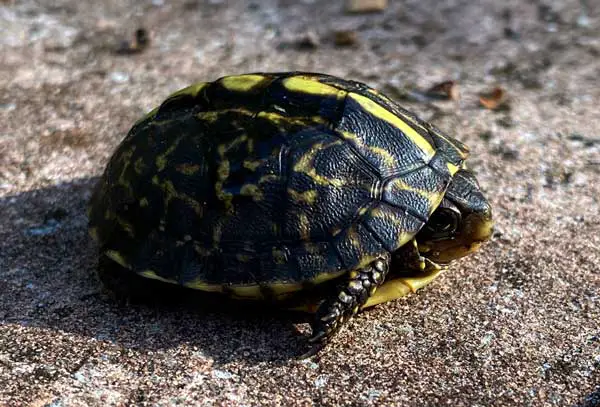
Follow these tips to take proper care of your baby Florida box turtle:
- Provide your turtle with a small enclosure and equip it with a heat lamp and UVB light source. Maintain healthy temperature (75-85°F) and humidity levels (60-70%) inside this enclosure.
- Clean your baby turtle’s habitat regularly to prevent the buildup of harmful bacteria and parasites that may affect your turtle’s health.
- Feed your turtle a balanced diet. Your baby turtle requires a more carnivorous diet so provide it with small insects, worms, mealworms, crickets, etc. As the turtle grows, you can start introducing it to vegetables and fruits as well.
- Take your turtle for regular vet checkups at least once every year to ensure it stays healthy.
Don’t forget to monitor the growth of your baby box turtle closely. As you already know, baby turtles grow pretty quick. And as they do, their needs also change and will require a larger enclosure.
Final verdict
Florida box turtle makes good pet if given proper care. Before you bring this turtle home, make sure you fully understand all its special needs and how to take good care of it. Be prepared to make a lifelong commitment to providing your turtle pet with everything it needs to stay happy and healthy at all times.
The above guide has provided you with essential care tips for your box turtle. We hope you can now provide a comfortable and healthy living environment for your turtle, feed him the right diet, and keep his health in check. Remember, proper care is the secret to your box turtle living for many years.
